From wolves to grey whales and lynxes, plans are afoot to introduce some iconic species back into the countryside and UK waters
George Monbiot
A new national organisation called Rewilding Britain launches on Wednesday with the aim of reversing centuries of ecological damage by returning species and habitats to the British countryside that have been absent for decades and sometimes much longer. In the process it hopes to recharge the natural world with wonder and help people to reconnect with it. Here are some of the species that have been lost to our countryside but may yet return:
Dalmatian pelican
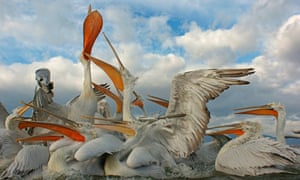
Pelicans once lived throughout Europe. The most recent record in Britain is a medieval bone found near Glastonbury. It’s an enormous bird, whose wingspan is just shy of that of the wandering albatross. There is plenty of suitable habitat in Britain, though it is strongly affected by disturbance when breeding, so potential sites would have to be selected carefully.
Bluefin tuna
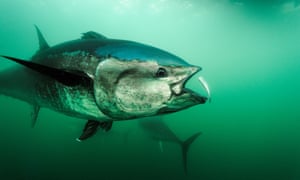
Until 80 years ago, shoals of giant bluefin tuna followed the herring and mackerel migrating round our coasts. For many years, the world record tuna caught on rod and line was one hooked a mile off Scarborough in 1933. Big game fishing by the grand personages who descended on the town for this sport every summer probably contributed to the tuna’s demise, as did overharvesting of the fish the tuna ate. Today they appear very rarely off our coasts, but would be likely to return if there’s a reduction in fishing pressure.
Grey whale
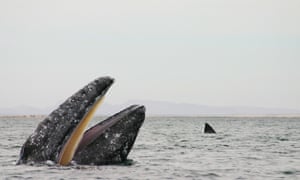
Grey whales fed in Britain’s estuaries and shallow bays until around 400 years ago, when they were hunted to extinction. Now the only remaining populations are in the Pacific, where they are the most popular species for whale watching, as they appear to have an affinity for people. It’s not yet clear whether bringing them back to Britain is logistically possible: they would have to be airlifted across several thousand miles.
Lynx
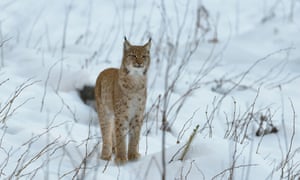
The youngest bone discovered in Britain so far is about 1,500 years old, though there are slightly later cultural records, including an apparent mention in Aneurin’s saga Y Gododdin, and a carving on a 9th-century stone cross on the Isle of Eigg. The lynx is a specialist roe deer predator, which is handy in a country whose deer population has boomed in recent years. There is no record or even anecdotal account of attacks on humans. Threats to livestock are limited by its reluctance to leave the woods in which it lives.
Beaver
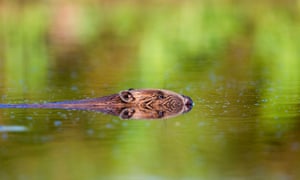
Beavers once lived in most of our rivers, and are commemorated in various place names, such as Beverley in Yorkshire, Beverston in Gloucestershire and Barbon in Cumbria. After becoming extinct here perhaps in the 18th century, they have recently been re-established in Knapdale in western Scotland, the River Tay in Perthshire and the River Otter in Devon. They have many beneficial effects on rivers, reducing floods, restoring incised (vertically eroded) stream beds and providing habitats for many other species.
Boar
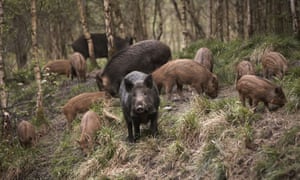
Wild boar are among the most important of Britain’s ecological engineers. By grubbing in the woodland floor, they increase the diversity of the plants that can grow there. They dig up bracken rhizomes, allowing tree seedlings to rise through what would otherwise be an impenetrable mat. Their wallows are a useful habitat for water-loving plants, insects and amphibians. Wild boar have escaped from farms and are at large in several parts of the countryside, but they are threatened by the government’s policy of allowing landowners to decide whether or not they should be allowed to survive.
Wolf
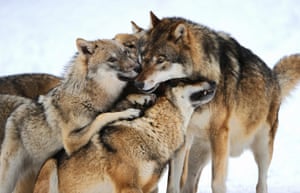
There’s some controversy about when the wolf became extinct in Britain, but the last certain record is an animal killed in Sutherland in 1621. Wolves are the most controversial species proposed for reintroduction here, and nothing is likely to happen for some decades. Their reputation for ferocity is undeserved: they go to great lengths to avoid people. But they do take livestock, which would need to be protected by dogs or other measures. Wolves are critical to the restoration of ecosystems, especially of places – like the Scottish Highlands – that are overgrazed by deer.
Common crane
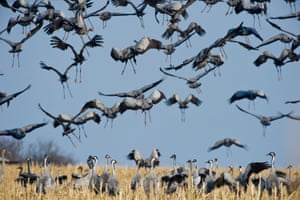
Cranes were once among the commonest breeding birds on British wetlands. They persisted here until the 16th century, when they were hunted to extinction. They have spontaneously returned to the Norfolk Broads, and have been reintroduced to Somerset. The magic of hearing their wild cries as they descend from their migrations – they can fly at 32,000 feet – defies all description.
Eagle owl
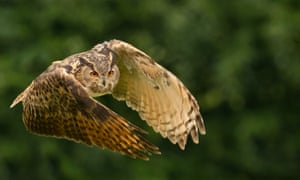
Because the fossil record is very sparse, it’s unclear when the eagle owl last lived here. The last certain bone is about 9,000 years old, though a possible specimen from the Iron Age has been found in Somerset. Nor is there any certainty about why it disappeared. A small number are living in Britain again, either escapees or migrants from elsewhere in Europe. This vast and beautiful bird is controversial among ornithologists, as it sometimes kills other raptors.
Pine marten
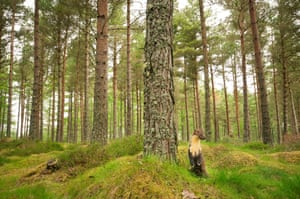
Following the spectacular preliminary findings from Ireland, where resurgent pine martens appear to have rolled back the grey squirrel population, allowing red squirrels to recolonise much of their old territory, there has been a surge of interest in restoring the species in Britain. While they persist in reasonable numbers in parts of Scotland, in England and Wales there are only tiny relict populations, whose expansion is limited by their narrow genetic base. Largely through the work of the Vincent Wildlife Trust, re-establishment programmes have begun in several places.
Goshawk
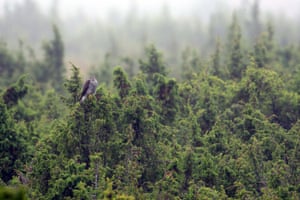
It was driven to extinction in the 19th century, mostly by gamekeepers, but it now clings on in small numbers, as a result of deliberate releases and escapes from falconers. It is still being illegally killed by gamekeepers. Like the pine marten, the goshawk hunts grey squirrels.
Night heron
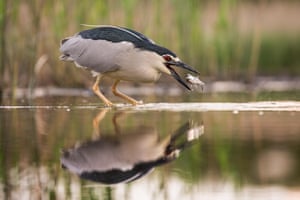
The night heron last bred here in the 16th or 17th century. It is believed to be the celebrated brewes or brues, served at mediaeval banquets. Its nocturnal feeding habits could be an important factor in shaping wetland ecosystems.
Sturgeon
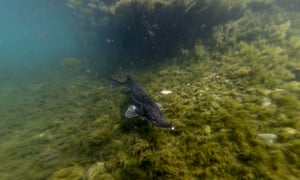
Of all the species considered for reintroduction here, the Atlantic sturgeon is perhaps the most difficult, as its restoration would require major improvements to both rivers and the sea. It was once a common fish in Britain, migrating through most of our river systems. It can grow to around 18 feet long. Now critically endangered by a combination of overfishing, pollution and the damning and wiering of the rivers in which it breeds, its last European breeding population is in the Gironde-Garonne-Dordogne basin in France.
White stork

The last year in which it is known to have bred successfully in this country was 1416, in Edinburgh. Occasional birds have arrived this century, and on a couple of occasions have tried to breed. Its habit of building on people’s roofs has made it one of the most-loved birds in Europe, and generated a rich folklore.
White-tailed eagle
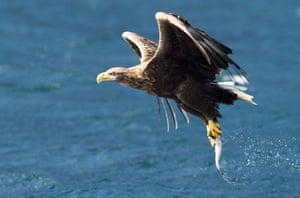
The white-tailed eagle once lived throughout the country, but was wiped out in Britain in 1916, by persecution and egg collecting. It was restored to the isle of Rum in 1975, and has since spread along the west coast of Scotland. Attempts to re-establish it in East Anglia failed as a result of vocal but poorly-informed opposition. In Finland, it has restricted the range of invasive American mink, that it plucks out of the water when they are swimming. This is likely to be of benefit to the many species on which mink prey.
